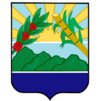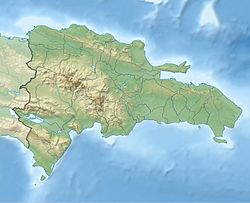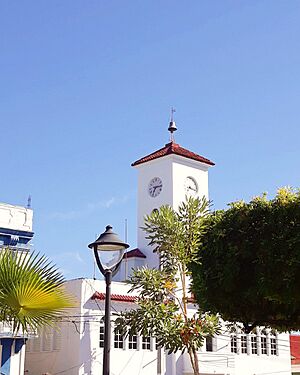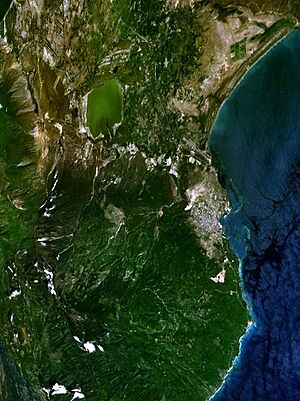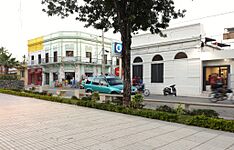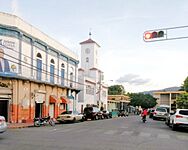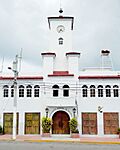Barahona, Dominican Republic facts for kids
Quick facts for kids
Barahona
|
||
|---|---|---|
| Santa Cruz de Barahona | ||

Villa Miriam
|
||
|
||
| Country | ||
| Province | Barahona | |
| Founded /Founder. =Toussaint L'ouverture | 1802 | |
| Municipality since | 1858 | |
| Area | ||
| • Total | 163.02 km2 (62.94 sq mi) | |
| Elevation | 10 m (30 ft) | |
| Population
(2012)
|
||
| • Total | 138,159 | |
| • Density | 847.497/km2 (2,195.01/sq mi) | |
| • Demonym | Barahonero(a) | |
| Municipal Districts | 3 | |
| Climate | Aw | |
Barahona, also known as Santa Cruz de Barahona, is an important city in the Dominican Republic. It is located in the southwest part of the country. Barahona is the main city of the Barahona Province.
This city has a very busy port. It is also known for its many ecotourism spots. Barahona is a big center for making sugar. It is also the only place in the world where you can find the rare Larimar stone.
Contents
History of Barahona
Before Europeans arrived, the area was home to the Native Taino people. It was part of the Jaragua chiefdom, led by Chief Bohechío.
The name Barahona comes from the first Spanish families who settled here. Some of these Spaniards were from a town called Baraona in Spain. They named the new place after their hometown. Francisco, Gabriel, Luis, and Juan de Barahona arrived with Christopher Columbus in the 1490s.
After the Dominican Republic became independent in 1844, Barahona was a military outpost. It was part of the Azua Province. In 1858, Barahona became a municipality. This means it got its own local government.
Later, in 1881, the Barahona Province was created. Barahona city became its main town. In 1907, Barahona was officially made a "commune" and the province was named after it.
A group called "El Salvador" was started in Barahona. Cuban revolutionaries formed it to help Cuba gain independence from Spain. The Dominican president, Ulises Heureaux, sent money and weapons to Cuban patriots from Barahona's shores.
Between 1916 and 1924, Americans were present in the province. They helped plant sugar cane and build large farms. In 1927, the first airline in the Caribbean started in Barahona. It offered flights between Barahona, Santa Cruz, San Juan (Puerto Rico), Santo Domingo, and Port-au-Prince (Haiti).
Barahona's Climate
Barahona has a tropical wet and dry climate. This means it has warm temperatures all year. The average temperature is about 24.8 °C (76.6 °F) in January. It goes up to about 28.0 °C (82.4 °F) in July.
The city has two rainy seasons. The first is from May to June. Then, it gets drier in July and August. This is because of a weather system called the Azores High. It stops clouds and rain from forming. The second rainy season is from September to October. The driest months are from December to April. Even then, some rain can still fall. Barahona gets a lot of sunshine all year, usually over 3200 hours.
| Climate data for María Montez International Airport (1991–2020) | |||||||||||||
|---|---|---|---|---|---|---|---|---|---|---|---|---|---|
| Month | Jan | Feb | Mar | Apr | May | Jun | Jul | Aug | Sep | Oct | Nov | Dec | Year |
| Mean daily maximum °C (°F) | 30.2 (86.4) |
30.3 (86.5) |
30.3 (86.5) |
30.7 (87.3) |
31.0 (87.8) |
31.6 (88.9) |
32.6 (90.7) |
32.8 (91.0) |
32.4 (90.3) |
31.7 (89.1) |
31.3 (88.3) |
30.7 (87.3) |
31.3 (88.3) |
| Daily mean °C (°F) | 25.3 (77.5) |
25.5 (77.9) |
26.0 (78.8) |
26.7 (80.1) |
27.3 (81.1) |
28.0 (82.4) |
28.5 (83.3) |
28.6 (83.5) |
28.1 (82.6) |
27.4 (81.3) |
26.7 (80.1) |
25.8 (78.4) |
27.0 (80.6) |
| Mean daily minimum °C (°F) | 20.4 (68.7) |
20.7 (69.3) |
21.6 (70.9) |
22.8 (73.0) |
23.6 (74.5) |
24.3 (75.7) |
24.5 (76.1) |
24.4 (75.9) |
23.7 (74.7) |
23.1 (73.6) |
22.2 (72.0) |
20.8 (69.4) |
22.7 (72.9) |
| Average precipitation mm (inches) | 23.3 (0.92) |
20.4 (0.80) |
51.2 (2.02) |
97.8 (3.85) |
147.4 (5.80) |
75.2 (2.96) |
49.2 (1.94) |
119.0 (4.69) |
119.5 (4.70) |
161.3 (6.35) |
99.6 (3.92) |
36.2 (1.43) |
1,000.4 (39.39) |
| Source: NOAA | |||||||||||||
| Climate data for Barahona (1961-1990) | |||||||||||||
|---|---|---|---|---|---|---|---|---|---|---|---|---|---|
| Month | Jan | Feb | Mar | Apr | May | Jun | Jul | Aug | Sep | Oct | Nov | Dec | Year |
| Record high °C (°F) | 33.2 (91.8) |
34.0 (93.2) |
33.8 (92.8) |
34.5 (94.1) |
34.7 (94.5) |
34.2 (93.6) |
35.6 (96.1) |
37.5 (99.5) |
35.8 (96.4) |
34.5 (94.1) |
34.0 (93.2) |
33.0 (91.4) |
37.5 (99.5) |
| Mean daily maximum °C (°F) | 29.3 (84.7) |
29.2 (84.6) |
29.5 (85.1) |
30.0 (86.0) |
30.3 (86.5) |
30.7 (87.3) |
31.7 (89.1) |
31.9 (89.4) |
31.5 (88.7) |
30.7 (87.3) |
30.6 (87.1) |
29.8 (85.6) |
30.4 (86.7) |
| Daily mean °C (°F) | 24.8 (76.6) |
25.0 (77.0) |
25.6 (78.1) |
26.3 (79.3) |
26.8 (80.2) |
27.4 (81.3) |
28.0 (82.4) |
27.9 (82.2) |
27.4 (81.3) |
26.6 (79.9) |
26.2 (79.2) |
25.3 (77.5) |
26.4 (79.5) |
| Mean daily minimum °C (°F) | 20.3 (68.5) |
20.7 (69.3) |
21.6 (70.9) |
22.6 (72.7) |
23.3 (73.9) |
24.1 (75.4) |
24.3 (75.7) |
24.0 (75.2) |
23.3 (73.9) |
22.6 (72.7) |
21.8 (71.2) |
20.7 (69.3) |
22.4 (72.3) |
| Record low °C (°F) | 15.0 (59.0) |
15.0 (59.0) |
17.0 (62.6) |
18.0 (64.4) |
19.2 (66.6) |
20.0 (68.0) |
19.5 (67.1) |
20.0 (68.0) |
20.0 (68.0) |
19.6 (67.3) |
16.6 (61.9) |
15.5 (59.9) |
15.0 (59.0) |
| Average rainfall mm (inches) | 30.4 (1.20) |
29.3 (1.15) |
45.1 (1.78) |
64.1 (2.52) |
168.5 (6.63) |
129.5 (5.10) |
38.1 (1.50) |
65.1 (2.56) |
143.7 (5.66) |
184.9 (7.28) |
75.6 (2.98) |
44.4 (1.75) |
1,018.7 (40.11) |
| Average rainy days (≥ 0.1 mm) | 3.7 | 3.2 | 3.9 | 6.1 | 10.6 | 8.2 | 3.8 | 5.1 | 8.8 | 10.6 | 4.8 | 2.4 | 71.2 |
| Average relative humidity (%) | 73.0 | 72.6 | 71.5 | 71.9 | 75.6 | 75.8 | 72.0 | 72.9 | 76.3 | 78.4 | 75.1 | 72.8 | 74.0 |
| Mean monthly sunshine hours | 259.6 | 248.8 | 286.7 | 271.5 | 261.0 | 264.7 | 289.3 | 286.5 | 243.2 | 259.0 | 267.7 | 268.6 | 3,206.6 |
| Source 1: World Meteorological Organization | |||||||||||||
| Source 2: NOAA | |||||||||||||
What Barahona Produces
Barahona has a mix of different ways to make money. These include farming, mining, and tourism. The city also has an industrial port and a special "free zone" for making clothes.
Some important companies here include:
- CEMEX Dominicana, which mines gypsum.
- Rica, which makes dairy products.
- Consorcio Azucarero Central, which produces sugar.
- EGE Haina, which generates electricity.
- Wilbes Dominicana, which has free trade areas.
- Block Khoury, which makes and sells building materials.
Farming is a big part of the economy. Farmers grow sugar cane, bananas, and coffee. They also grow fruits, sorghum, yams, and yautia. The "Barahona Type Coffee" is very famous. It grows in the nearby mountains.
Raising animals is also important. People raise cattle and goats for meat and leather. Milk production is also growing.
Mining is another key activity. Barahona is known for its unique larimar stone. Other mined materials include marble, plaster, alabaster, and kaolin. Kaolin is used to make bottles. Mineral salt and building materials are also mined here.
Downtown Barahona
Getting Around Barahona
Barahona has a busy seaport. Many ferries from other Caribbean islands arrive here. The city also has an airport called María Montez International Airport. It is about 10 minutes from the city center. The airport has recently started having more flights. It now has a fuel station for planes. The port is even closer, about 5 minutes from the city center.
Famous People from Barahona
- Julio Lugo, a baseball player (shortstop) for the Boston Red Sox.
- Ruddy Lugo, a baseball player (relief pitcher) for the Oakland Athletics.
- Maria Montez, a famous actress.
- David Thomatis, an agricultural expert from Italy and Australia.
- Ludo Vika, an actress and comedian.
- Edinson Vólquez, a baseball player (pitcher) for the Kansas City Royals.
See also
 In Spanish: Barahona (República Dominicana) para niños
In Spanish: Barahona (República Dominicana) para niños


